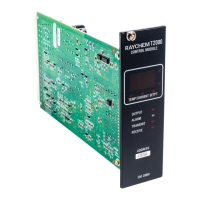28 | nVent.com
IMPORTANT:
• Ensure that TS FAILURE ALARMS are enabled. See Sections 3.4, 3.5.7, and 3.5.8 for a
complete explanation of RTD failure detection in the control module.
• If the selected TS CONTROL MODE is ATC SLAVE then the CONTROL TS FAILURE ALARM
is non-latching and the load shedding fail safe mode is always disabled. Also, the three-
character display will display “Atc” in place of the CONTROL SETPOINT temperature. If
there is no ATC signal present, then three-character display will flash “AtF” in place of the
CONTROL SETPOINT temperature and the output will be off.
3.4.12 ATC MASTER MODE (V2.35 AND UP)
Purpose: If a control module is not configured as an ATC SLAVE, it can be configured as an
ATC MASTER. In this mode a control module will control its own output as well as the outputs
of any control module which is configured as an ATC SLAVE. When a control module is
configured as an ATC MASTER the three-character display will display “FrP” immediately after
the CONTROL SETPOINT temperature is displayed.
Setting: YES or NO
Procedure: If a control module is to be an ATC MASTER then select YES, otherwise select NO.
IMPORTANT:
• It is possible to have more than one ATC MASTER control module controlling a group of
ATC SLAVE control modules. The ATC SLAVES will have their outputs on if one or more ATC
MASTER is instructing them to have their outputs on. Otherwise the ATC SLAVES will have
their outputs off.
• If an ATC MASTER controls its own output using either the DEADBAND or PROPORTIONAL
control modes then it will control its ATC output using the DEADBAND control mode. If an
ATC MASTER controls its own output using either the PROPORTIONAL AMBIENT SSR or
PROPOR-TIONAL AMBIENT CONTACTOR control modes then it will control its ATC output
using the PROPORTIONAL AMBIENT CONTACTOR control mode.
• For control modules with firmware versions V3.18 and up, the ATC output signal of an ATC
MASTER is not affected by load shedding or fail safe modes, auto-cycling, EEROM data
failure, GFI trip, or overcurrent trip.
• For control modules with firmware versions V3.18 and up, if an ATC MASTER controls
its output using either the PROPORTIONAL AMBIENT SSR or PROPORTIONAL AMBIENT
CONTACTOR control modes, and a control temperature failure occurs, then the ATC output
signal will remain unchanged until the current duty cycle expires.
3.4.13 VOLTAGE TURNS RATIO ADJUSTMENT
Purpose: The VOLTAGE TURNS RATIO adjusts voltage readings for applications where a
control module is switching a load through a step-up or step-down transformer, or is being
powered from a source with a different voltage level than the trace voltage.
Range: 0.10 to 9.90 (TO 1)
Procedure: Adjust the VOLTAGE TURNS RATIO to equal the ratio of the heating circuit voltage
to the control module input voltage. Compare the voltage indicated by the control module to
the actual measured heating circuit voltage after setting the turns ratio and adjust until the two
readings are as close as possible.
Example:
Heating Circuit Voltage: 480 Volts
Control Module Input Voltage: 120 Volts
VOLTAGE TURNS RATIO Setting: 4.00 To 1
IMPORTANT: When the VOLTAGE TURNS RATIO has been set appropriately, the control module
will calculate the heating circuit power using the adjusted current and voltage readings. Voltage
alarms also use the adjusted voltage reading.

